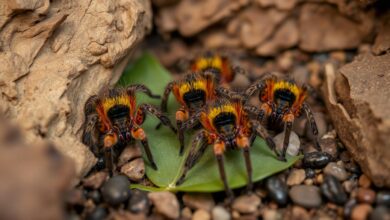Camouflage and mimicry strategies to avoid predators
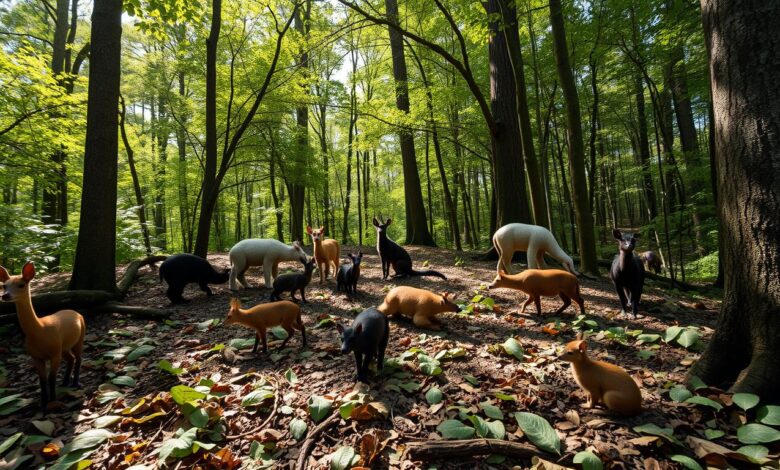
In the vast natural world, animals have developed amazing ways to hide from predators. They use camouflage and mimicry to stay safe. These tricks include colors that blend in and shapes that look like rocks or leaves.
Mimicry is another clever trick. Harmless animals look like dangerous ones to avoid being eaten. This way, they trick predators into thinking they are not safe to eat. This is called Batesian mimicry.
But there’s more. Müllerian mimicry happens when many harmful animals look alike. This makes predators even more careful, as they learn to avoid all of them.
The constant battle between predators and prey drives these survival tricks. By studying these tactics, we learn about the amazing diversity of life. It shows how life on Earth is incredibly resilient and adaptable.
The Role of Camouflage in Prey Survival
Camouflage is a clever trick that helps prey hide from predators. It comes in two main types: cryptic coloration and disruptive patterns. Cryptic coloration lets an animal blend into its surroundings, making it hard to see. Disruptive patterns, by contrast, confuse predators by breaking up an animal’s outline.
Cryptic Coloration and Disruptive Patterns
Many prey animals have cryptic coloration to hide in plain sight. For instance, the green tree python’s green scales help it blend into the rainforest. The Arctic hare’s coat changes color with the seasons, staying hidden all year.
Disruptive patterns are another clever way to hide. These patterns, like the zebra’s stripes, make it hard for predators to see the animal’s shape. This helps the zebra stay safe from lions.
Masquerade: Mimicking Inanimate Objects
Some prey animals take camouflage to the next level with masquerade. They look like sticks, leaves, or stones to hide. The walking stick insect is great at this, looking just like a twig.
These camouflage strategies help prey animals survive. By hiding, they avoid predators and increase their chances of living longer. This is why they can pass on their hiding skills to their young.

Mimicry: Deceiving Predators through Imitation
Mimicry is a clever way for species to avoid predators. It’s when one species looks like another to use its defenses. This trick can really help them stay safe.
Batesian Mimicry: Harmless Species Mimic Toxic Ones
Batesian mimicry is a famous example. A harmless species looks like a toxic one to keep predators away. Batesian mimicry is seen a lot in insects, like the Viceroy butterfly copying the Monarch butterfly’s look.
Many things can affect how common Batesian mimicry is. Things like where the species live and the weather matter. Genetics also help these species look like they belong.
But, Batesian mimicry isn’t always perfect. Some predators can tell the difference. Still, it’s a fascinating way species have found to protect themselves.
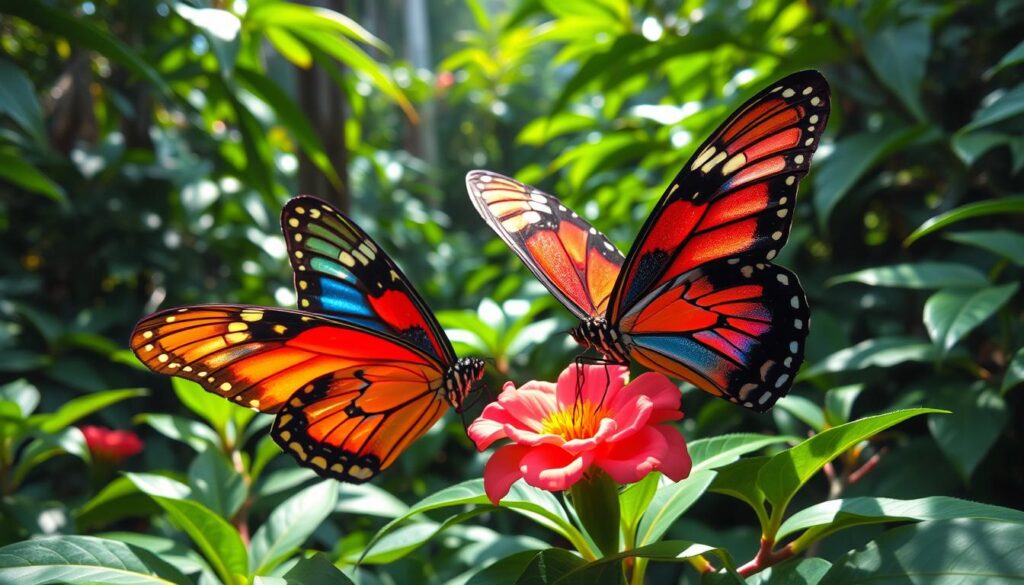
Evolutionary Origins of Camouflage and Mimicry
The wide range of camouflage and mimicry in nature comes from natural selection. Animals that can hide or fool predators are more likely to live and have babies. This means they pass on their good traits to their young. Over time, natural selection makes these predator avoidance tactics better, showing us the amazing variety of camouflage and mimicry adaptations today.
Natural Selection and Predator Avoidance Tactics
Mimicry is common in animals, from insects to mammals. There are two kinds: Batesian mimicry and Mullerian mimicry. Mimicry tricks predators into thinking something is dangerous, keeping the real animal safe.
Butterflies like the Viceroy and Monarch mimic toxic species to avoid being eaten. They also mimic sounds and behaviors to stay alive. Even orchids mimic female insects to get pollinated. Octopuses are experts at changing color and texture to hide.

The evolutionary origins of these amazing tricks are rooted in natural selection. Animals that can avoid predators better are more likely to live and have kids. This leads to the development of many camouflage and mimicry strategies over time.
Camouflage and Mimicry in Caterpillars
Caterpillars are more than just plant-eaters. They use clever camouflage and mimicry to avoid predators. This helps them survive better.
The caterpillar of the wavy-lined emerald moth is a great example. It can attach flower bits to its body using silk. This makes it look like a part of the flower. Many insects, like katydids and walking sticks, do the same thing.
Some caterpillars look like they have warning colors. This is called Batesian mimicry. For example, the viceroy butterfly looks a lot like the monarch butterfly. The monarch is toxic, so predators stay away. Even without the monarch, the viceroy can look unappetizing by storing toxins.
Caterpillars have many ways to avoid being eaten. They can look like bird droppings or show bright colors. These strategies show how clever nature can be.
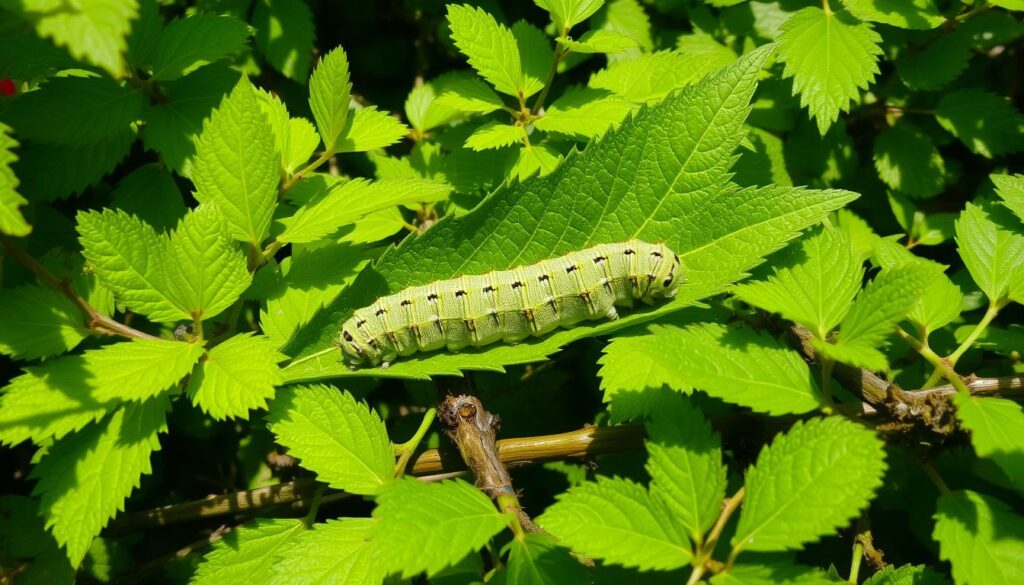
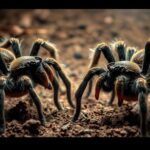 Aggressive behavior between tarantulas of the same species, especially during mating
Aggressive behavior between tarantulas of the same species, especially during mating
From the wavy-lined emerald moth to the viceroy butterfly, caterpillars are very good at hiding. Their camouflage and mimicry show the amazing diversity of nature.
Baited Remote Underwater Video (BRUV) for Monitoring Fish Diversity
Researchers are using new methods like Baited Remote Underwater Video (BRUV) to study fish. BRUV is a cost-effective, non-invasive way to see more fish than old methods like gillnets and seine nets.
Advantages of BRUV over Traditional Sampling Methods
BRUV uses bait to attract fish, catching big, mobile species that other methods miss. It’s great for studying how human activities, like dam building, affect rivers. Unlike gillnets or seine nets, BRUV doesn’t harm the fish it observes.
- Captures a more diverse range of fish species, including large, mobile species
- Non-invasive and non-destructive, ensuring the well-being of the fish
- Cost-effective and can be deployed in remote or hard-to-access areas
- Provides a visual record of the fish community, allowing for detailed analysis
A study using BRUV in a 240 km river stretch over 7 years showed big changes. Before a dam was built, there was a lot of fish diversity. But after the dam started operating, fish diversity and numbers dropped a lot. Yet, there was an unexpected rise in diversity between different parts of the river.
| Metric | Pre-Belo Monte | Post-Belo Monte |
|---|---|---|
| Alpha Diversity | High | Steep Decline |
| Abundance | High | Steep Decline |
| Gamma Diversity | High | Significant Reduction |
| Beta Diversity | Low | Unexpected Increase |
BRUV shows how human actions affect rivers, giving us important information. This helps us make better plans for protecting and managing our waterways.
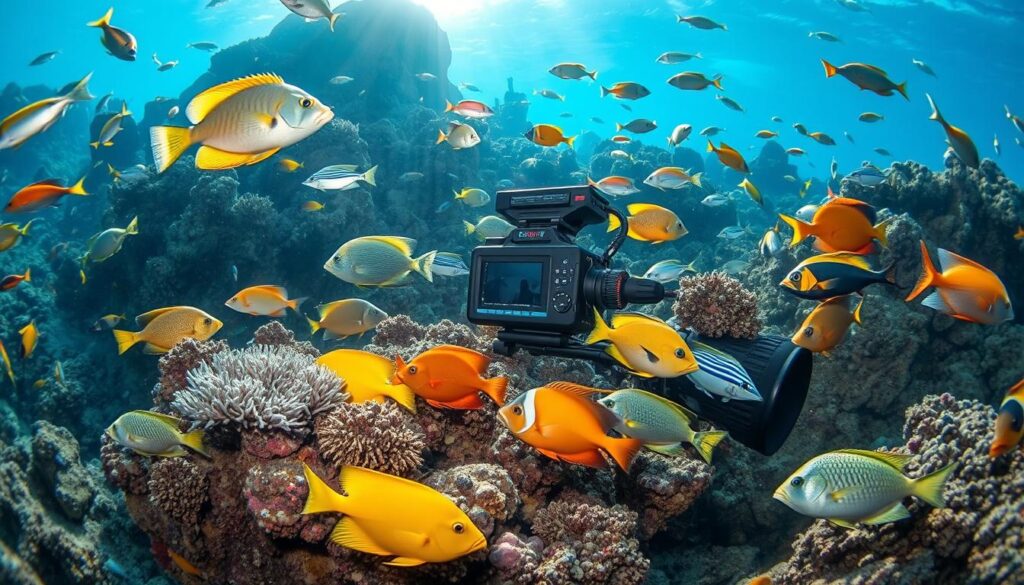
Impact of Dams on Fish Communities
Dams can harm freshwater fish communities a lot. They block fish migration and favor only a few species. Downstream, water flows and habitats suffer, affecting food webs.
Habitat Fragmentation and Loss of Connectivity
Habitat fragmentation hurts fish diversity. For example, the Belo Monte dam, the third largest, has caused big declines in fish diversity and numbers. It also reduced gamma diversity significantly.
But, there’s been an increase in beta diversity over time. This might be due to less river connection and more environmental variety. Yet, signs of recovery have been seen in recent years, thanks to higher flow levels.
With over 300 new dams planned in the Amazon, fish communities are at risk. The Santo Antônio and Jirau dams have already hurt local fishers’ income. This is because of fewer migratory species.
It’s important to understand these effects to lessen dams’ impact on aquatic ecosystems. New monitoring tools, like the Baited Remote Underwater Video (BRUV) method, are helping us see these impacts clearly.
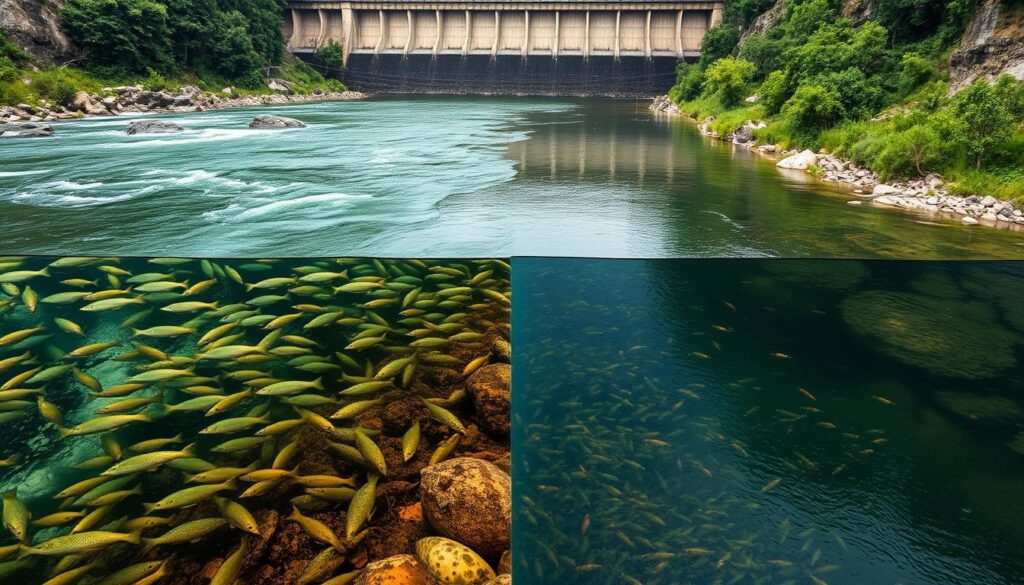
Rheophilic Fish Species: Vulnerable to Hydropower Impacts
The Amazon basin is home to a wide variety of aquatic life. However, it faces a big threat from the growth of hydropower projects. The rheophilic fish species, which live in fast-flowing waters, are especially at risk. These fish are hard to find because they live in areas that are hard to reach.
Building dams changes the water flow, habitat, and how areas connect. This can lead to fewer rheophilic fish and less variety. These sensitive species need fast-water habitats to survive. When their homes are disrupted, it affects the whole ecosystem.
| Key Impacts of Hydropower on Rheophilic Fish | Consequences |
|---|---|
| Habitat fragmentation and loss of connectivity | Disruption of migratory patterns and isolation of populations |
| Alteration of water flow regimes | Reduction in availability of fast-flowing, oxygen-rich habitats |
| Sedimentation and changes in substrate composition | Loss of critical spawning and feeding grounds |
To study and protect rheophilic fish, scientists use new methods like Baited Remote Underwater Video (BRUV). This method is better than old ways because it finds big, hard-to-catch fish in rapids.

With more hydropower projects coming to the Amazon, saving rheophilic fish and other sensitive species is key. We need to use the latest monitoring tools and find ways to keep fast-water habitats safe. This way, we can help keep the Amazon’s ecosystem in balance.
Camouflage and mimicry strategies to avoid predators
In the natural world, prey species have developed amazing camouflage and mimicry strategies to avoid predators. These clever adaptations, shaped by evolution, help animals blend in or look like something else. This way, they hide from potential threats.
One common prey concealment technique is cryptic coloration. Animals match their colors and patterns to their surroundings. For example, in Nebraska, the white-banded crab spider and the goldenrod crab spider can change color. They turn white or yellow to match flowers and catch prey.
Batesian mimicry is another clever trick. A harmless species looks like a toxic one to scare off predators. The viceroy butterfly looks like the monarch butterfly to avoid being eaten.
Camouflage and mimicry aren’t just for insects and spiders. Many animals, including vertebrates, use these tricks. Even predators, like cheetahs, have special ways to hunt. They target prey that have their own camouflage and mimicry.
Understanding how predators and prey adapt to each other is key. It shows us the balance in ecosystems and the ongoing evolutionary arms race in nature.
| Camouflage Technique | Description | Examples |
|---|---|---|
| Cryptic Coloration | Matching the color and pattern of the surrounding environment | Crab spiders, stick insects, leaf-tailed geckos |
| Disruptive Patterns | Breaking up the body outline with contrasting colors and shapes | Zebras, giraffes, some species of fish |
| Masquerade | Resembling inanimate objects or other species to avoid detection | Leaf-tailed geckos, walking sticks, some species of caterpillars |
| Mimicry | Imitating the appearance of toxic or unpalatable species | Viceroy butterflies, coral snake mimics, various moth species |
Prey species use many camouflage and mimicry strategies to stay safe. These tricks, shaped by natural selection, show the cleverness and resilience of life. They help animals survive and thrive in the wild.
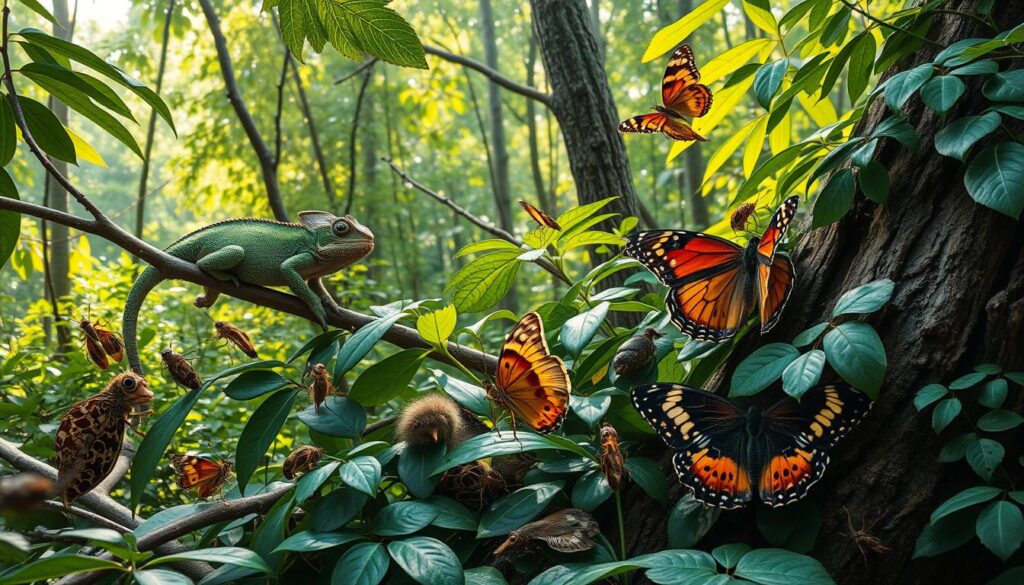
Temporal Variations in Fish Diversity After Dam Construction
Dams can have complex effects on fish communities. These effects may take decades to show up. At first, dams might increase fish numbers and variety. But over time, these numbers usually go down as rivers become less connected and habitats break apart.
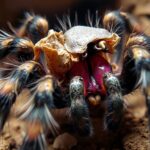 Relationship between molting and behavioral changes in tarantulas
Relationship between molting and behavioral changes in tarantulas
It’s key to watch how fish communities change over time and space. This helps us understand the lasting effects of dams. In the Xingu River, studies using underwater cameras showed interesting changes in fish diversity over 7 years.
These studies found big drops in the number of fish species and their abundance after the dam started working. But, surprisingly, the overall variety of species in the area also went down. Yet, the differences in fish communities between different spots actually increased.
But, in the later years of the study, there were signs that fish diversity might be recovering. This shows that fish communities can bounce back. It also shows how dams can have complex effects on water life, making long-term studies very important.
With over 300 dams planned or being built in the Amazon, knowing how fish diversity changes is vital. It helps make better decisions and protect water life.
| Metric | Trend | Explanation |
|---|---|---|
| Alpha (α) Diversity | Declined | Reduction in local species richness and abundance due to habitat fragmentation and loss of connectivity. |
| Gamma (γ) Diversity | Declined | Overall species richness in the region decreased over time, likely due to the cumulative impacts of multiple dams. |
| Beta (β) Diversity | Increased | Greater dissimilarity in fish communities between different sites, possibly indicating a shift in species composition. |
The Baited Remote Underwater Video (BRUV) method is better than old ways of counting fish. It gives more accurate numbers of species and how many there are. This is because it uses bait to attract fish, helping find big, moving species that are hard to spot otherwise.

Snakes That Employ Camouflage and Mimicry
Snakes use camouflage and mimicry to hide from predators, just like insects and small animals. The Asian vine snake, boomslang, and green mambas are bright green, blending into trees. The green tree python is especially good at hiding, looking like a part of the leaves.
Green Tree Pythons and Their Distinctive Coiled Posture
The green tree python lives in New Guinea and northern Australia’s rainforests. It has a special way of resting, coiling its body tightly. This makes it look like a ball of leaves or vines.
Its bright green color and coiled posture make it almost invisible. This helps it avoid being seen by predators and prey. It’s a clever way to stay safe in its tree home.
| Snake Species | Camouflage Adaptation |
|---|---|
| Asian Vine Snake | Bright green coloration |
| Boomslang | Bright green coloration |
| Green Mambas | Bright green coloration |
| Green Tree Python | Distinctive coiled resting posture |
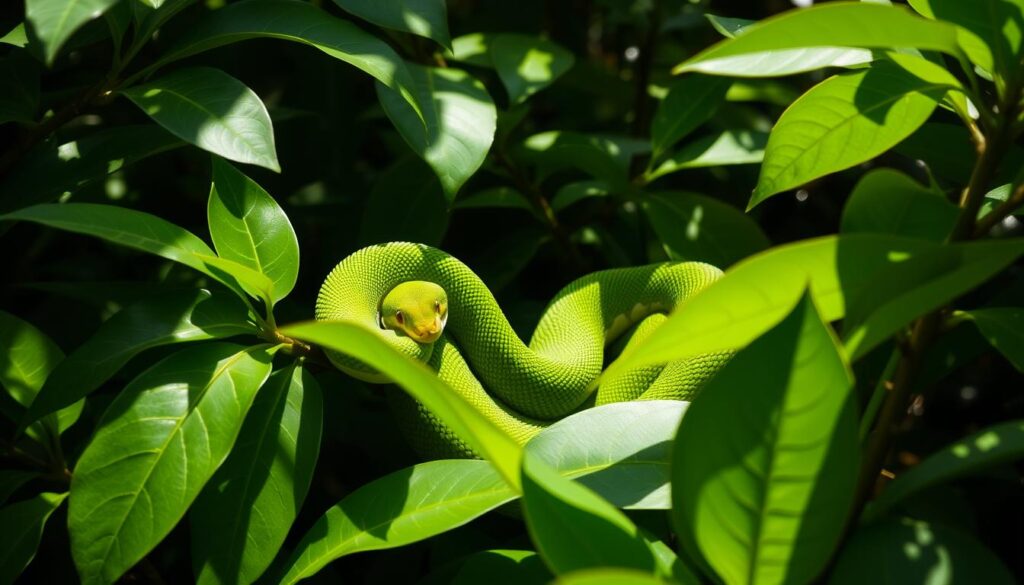
Snakes’ use of camouflage and mimicry is amazing. It shows how animals adapt to survive. From their bright colors to the green tree python’s unique pose, snakes have many ways to hide.
Anti-Predator Adaptations in Insects
Insects have developed clever ways to avoid predators. Adult butterflies are famous for their camouflage and mimicry. But, research shows that even caterpillars use these tactics to stay safe.
Some caterpillars look like bird droppings or twigs. This makes them hard to spot and keeps predators away. This trick is called masquerade.
Caterpillars also use warning coloration to scare off predators. They look like they might be toxic or bad-tasting. This is called Batesian mimicry. It makes predators think twice before attacking.
These survival tricks are important for insects at all stages. Caterpillars’ use of camouflage and mimicry shows how vital these strategies are. They help insects survive in a world full of dangers.
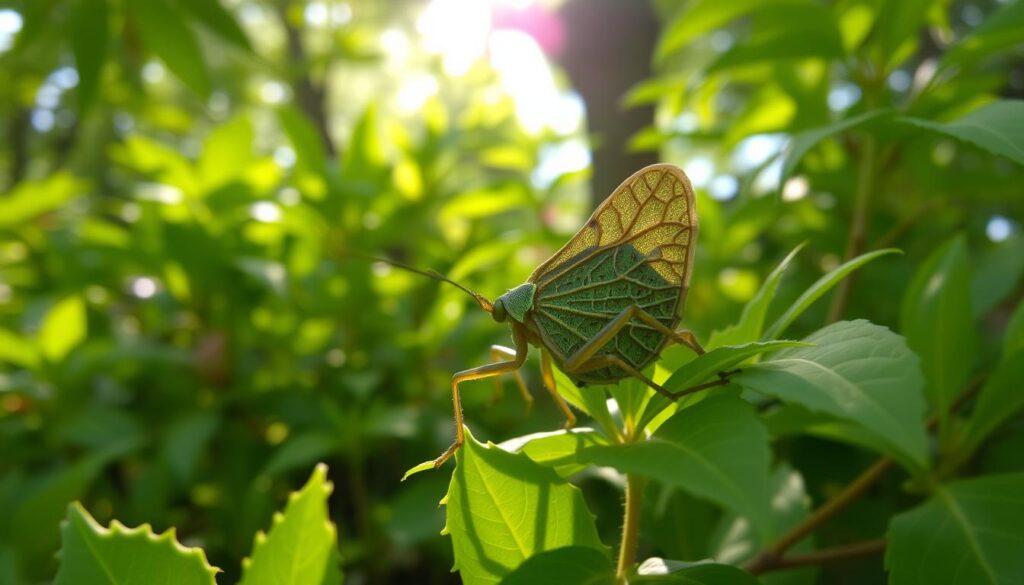
Insects use many ways to hide and look like something else. This shows how well they can adapt and survive. Their clever tricks fascinate scientists and nature lovers. They give us a glimpse into the complex world of predator and prey.
Protective Resemblance: Blending into the Environment
In the natural world, animals have developed amazing ways to hide from predators. One key strategy is protective resemblance. This means their colors and patterns help them blend into their surroundings. This camouflage helps them stay hidden and boosts their survival chances.
Countershading and Disruptive Coloration
Countershading is when an animal’s belly is lighter than its back. This makes it look flat and hard to spot. Another trick is disruptive coloration. This creates patterns that hide an animal’s shape, making it blend in better.
These tricks, shaped by natural selection, help animals hide from predators. They show how animals adapt to their environments. By using protective resemblance, countershading, and disruptive coloration, animals can stay safe from threats.

The evolution of these camouflage methods shows the ongoing battle between predators and prey. It highlights the clever ways animals have to survive. By studying these adaptations, we learn more about the complex life web and how nature helps its creatures thrive.
The Role of Camouflage in Predator-Prey Interactions
Camouflage is key in the battle between predators and prey. It helps prey animals hide and avoid being caught. This makes predators work harder to find them, leading to a never-ending race of survival.
From leaf insects that look like leaves to crab spiders that change color, nature is full of clever hiding tricks. Learning about camouflage helps us see the amazing ways animals survive and thrive.
Monarch butterflies warn predators with their bright colors, while anglerfish use fake lures to catch prey. The superb lyrebird even mimics sounds and movements of other animals. These examples show how diverse and clever camouflage can be in nature.
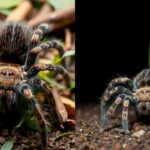 Different defensive behaviors used by tarantulas in the wild and in captivity
Different defensive behaviors used by tarantulas in the wild and in captivity


